Definition of Coaching
- Coaching:
- a collaboration process when coaches direct individuals/groups, help to accomplish goals, develop skills, achieve results through guidance, support, and motivation (Garvey, Stokes, & Megginson, 2014).
- Managers:
- organize processes, delegate tasks, control performance, react to outcomes.
- Coaches:
- set goals, develop plans, apply an individual approach, assign responsibility, support, provide feedback, communicate, and guide employees (Hunt & Weintraub, 2016).
To succeed in their work with other people, managers should also develop as coaches because this approach allows for building more effective partnerships with employees, and these partnerships are important for achieving strategic goals in Indian Creek Foundation.
Coaching can be defined as a process of collaborating with people, during which a coach directs an individual or a group of persons and helps to accomplish goals, develop skills, achieve higher results through guidance, support, and motivation (Garvey, Stokes, & Megginson, 2014).
From this point, in comparison to managers who usually organize processes for groups of people, delegate tasks, control performance, and react to outcomes, coaches focus on setting goals, developing plans to achieve these goals, applying an individual approach, assigning responsibility, supporting, providing feedback, and communicating to guide employees (Hunt & Weintraub, 2016).
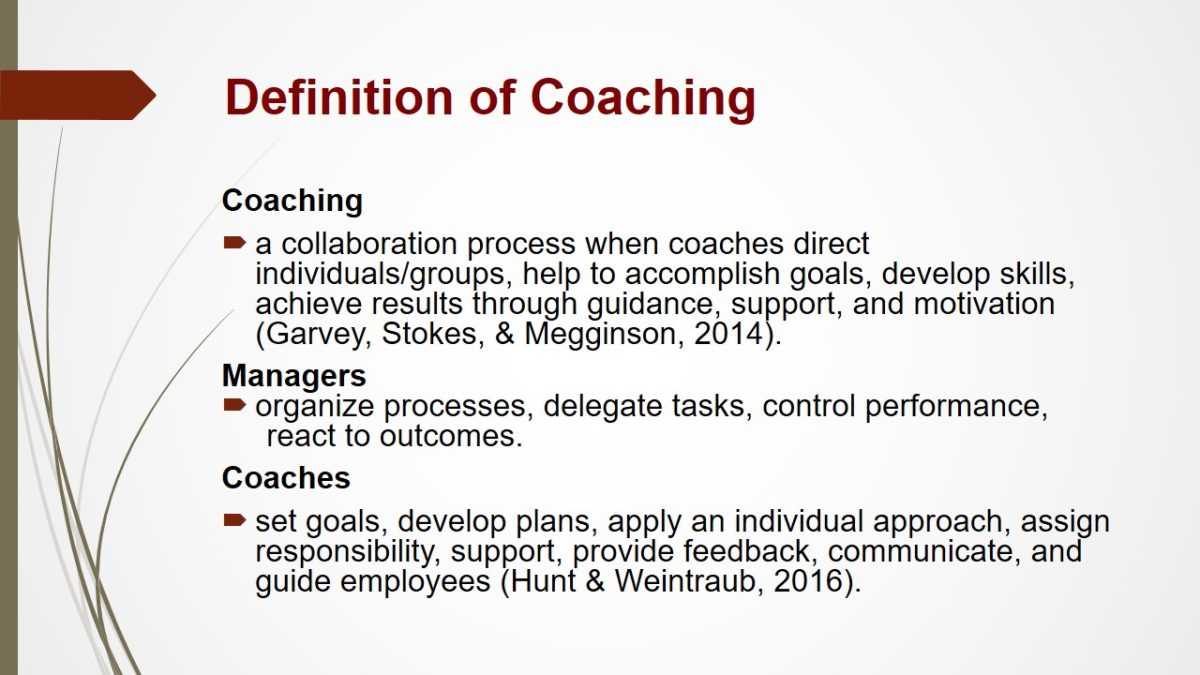
Effective Coaches
- Coaches’ characteristics and abilities:
- abilities to inform, guide, teach, train, and develop;
- abilities to support, advise, and assist;
- abilities to recognize, motivate, encourage, and empower (Kotylak, Michałowska, & Danielak, 2015).
- Effective coaches:
- good trainers and educators;
- perfect communicators and motivators;
- good listeners;
- positive, active, supportive, enthusiastic, and observant;
- patient, tactful, and respectful (Berg & Karlsen, 2016).
In contrast to managers, coaches have a set of specific characteristics that help them build strong positive relationships with employees and improve their performance, productivity, and commitment. These characteristics include three groups of abilities: a) abilities to inform, guide, teach, train, and develop; b) abilities to support, advise, and assist; c) abilities to recognize, motivate, encourage, and empower (Kotylak, Michałowska, & Danielak, 2015).
As a result, effective coaches are good trainers and educators, as well as perfect communicators and motivators. In addition to the listed qualities, effective coaches are also positive, active, supportive, enthusiastic, and observant. They are good listeners. Furthermore, effective coaches need to be patient, tactful, and respectful (Berg & Karlsen, 2016). All these qualities allow them to establish the mutual understanding with employees in order to support and empower them.
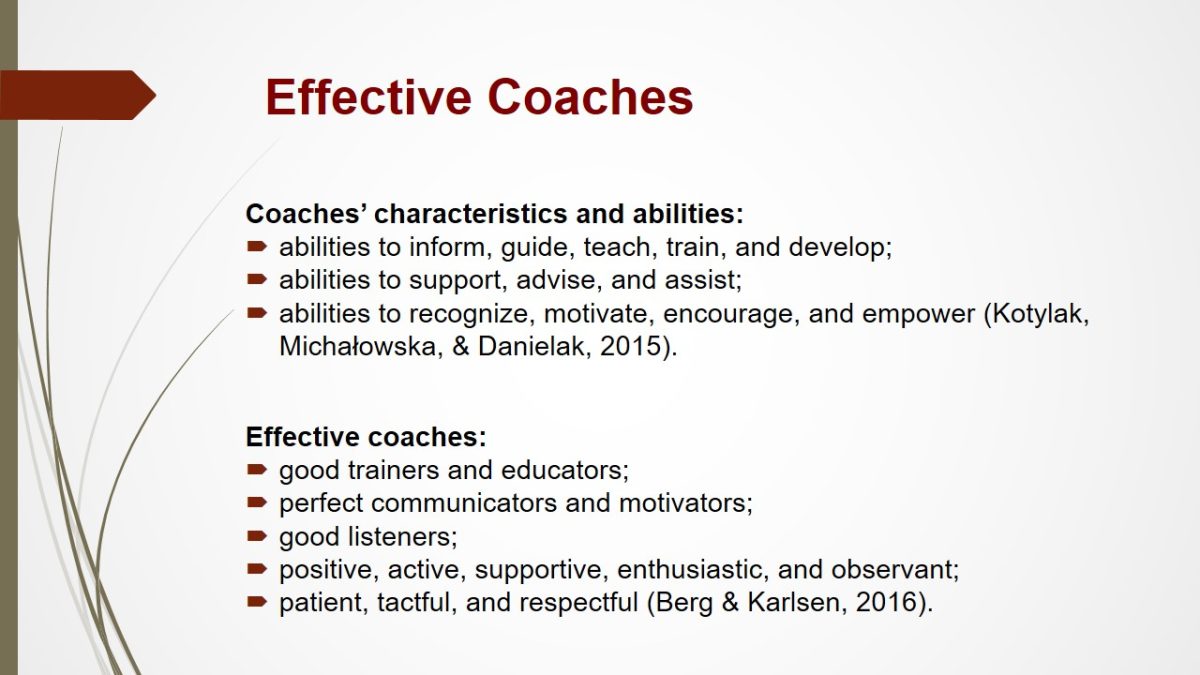
Specific Coaching Strategies
- Questionsto Answer:
- What is coaching?
- What coaching is required for employees in this organization?
- What are the purposes of this coaching?
- What outcomes are expected?
- What techniques can be applied to effectively work with these individuals?
- Coaching Plan:
- specific, realized within the shortest period of time, oriented to individuals’ needs (Garvey et al., 2014).
- Indian Creek Foundation:
- coaching strategies should be directed toward helping employees become motivated to assist and support other people.
To become a successful coach, it is important to establish a specific coaching strategy that is appropriate for an individual or for a certain group of persons.
To plan a coaching strategy, it is necessary to answer the following questions: What is coaching? What coaching is required for employees in this organization? What are the purposes of this coaching? What outcomes are expected? What techniques can be applied to effectively work with these individuals? Thus, answers to these questions depend on the needs of employees at a particular moment. From this point, any coaching plan should be specific, realized within the shortest period of time, and oriented to an individual and his or her needs (Garvey et al., 2014).
For Indian Creek Foundation, coaching strategies should also be directed toward helping employees become motivated to assist and support other people.
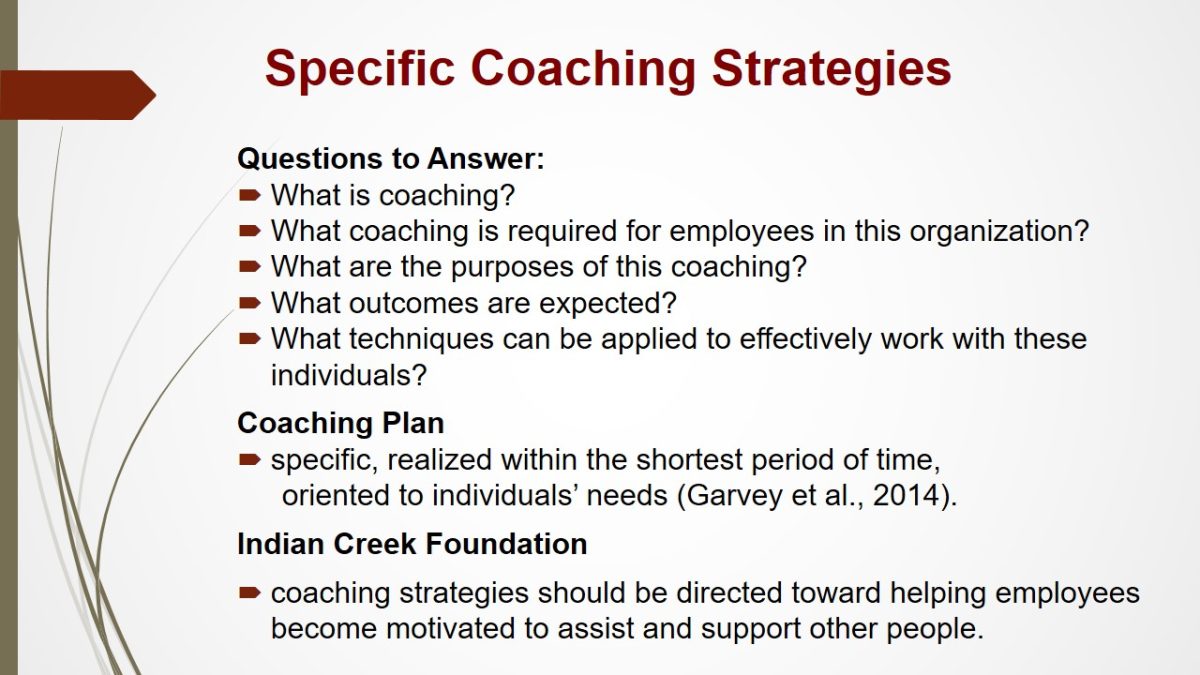
Personality Types
Coaches need to understand diverse personality types.
Personality types differ depending on the Myers-Briggs Type Indicator:
- Introversion;
- Extraversion;
- Sensing;
- Intuition;
- Thinking;
- Feeling;
- Judging;
- Perceiving (Hunt & Weintraub, 2016).
All people are different in terms of their personality types, learning styles, and abilities to perform certain tasks. To work with employees successfully, coaches need to understand diverse personality types.
Thus, personality types can be distinguished depending on the following aspects: introversion, extraversion, sensing, intuition, thinking, feeling, judging, and perceiving (Hunt & Weintraub, 2016). These types can be learned referring to the Myers-Briggs Type Indicator.
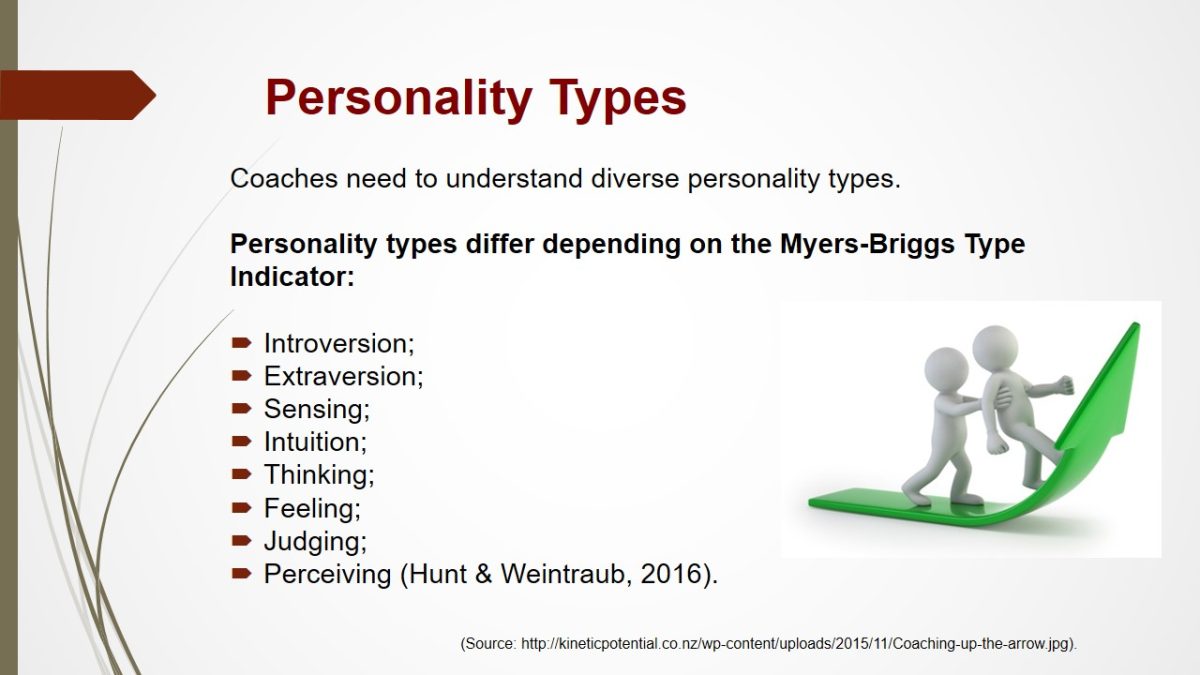
Motivating Diverse Employees
- Individual approaches to motivating and empowering employees:
- to evaluate the personality type using the Myers-Briggs Type Indicator;
- to evaluate the personality type using other similar tests;
- to develop strategies to motivate employees depending on their personality types (Theeboom, Beersma, & Van Vianen, 2014).
Each employee is unique!
Employees can be different in terms of their personality types, and each employee requires an individual approach to become motivated and empowered. Firstly, it is important to evaluate the personality type using the Myers-Briggs Type Indicator and other similar tests. Secondly, a coach needs to develop a strategy in order to motivate this or that employee depending on his or her personality type and other important qualities (Theeboom, Beersma, & Van Vianen, 2014). For instance, a coach can help an extravert while listening to him or her, and a coach can help an introvert while providing him or her with points to reflect on. It is important to remember that each employee is unique, and diverse employees require individual approaches to be motivated and stimulated.
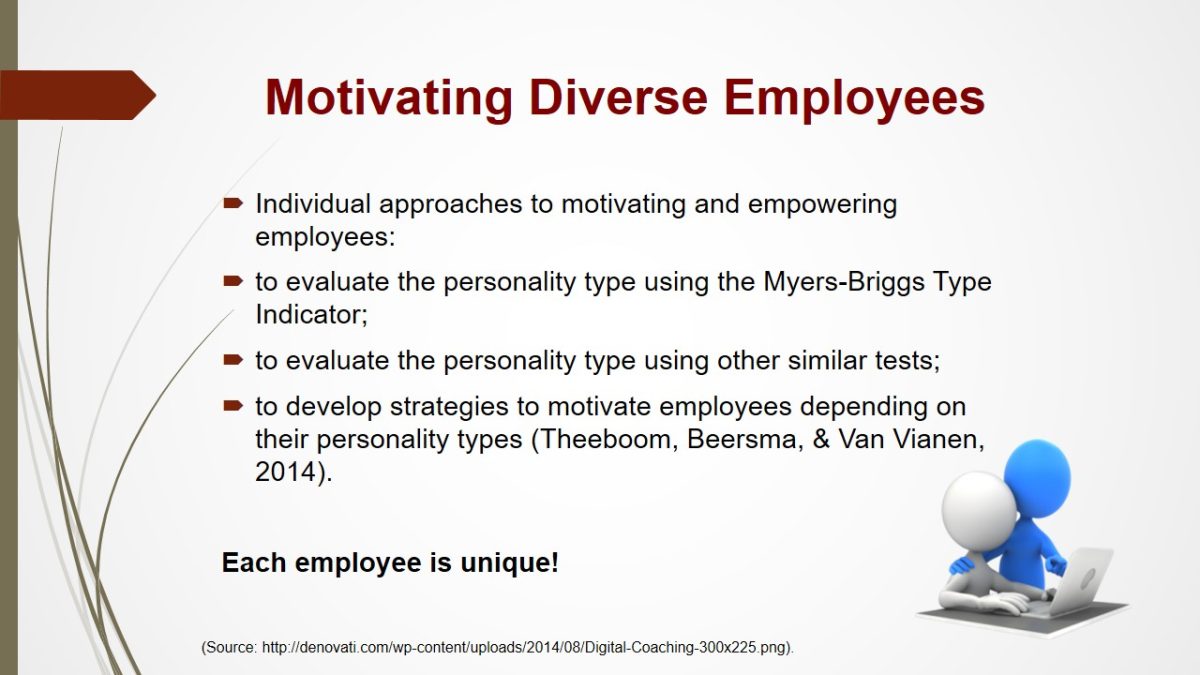
Building Coach-Employee Relationships
Trusting relationships between coaches and employees = partnerships:
- employees view coaches as supporters and sources of knowledge and advice;
- coaches understand that the discussed information is important for employees;
- coaches are supportive, willing to help, patient, respectful, and empowering (Garvey et al., 2014).
To be able to help employees, a coach needs to build trusting relationships. In this case, trusting relationships between coaches and employees are partnerships, in which employees view coaches as persons who can support them, provide with knowledge and advice, as well as to guide. Employees should understand that any details discussed with coaches cannot be used against them during assessments or other processes. Thus, to build strong coach-employee trusting relationships, coaches need to be supportive, willing to help, patient, respectful, and empowering (Garvey et al., 2014).
This principle also works while training employees on how to communicate with those people who are clients of Indian Creek Foundation.
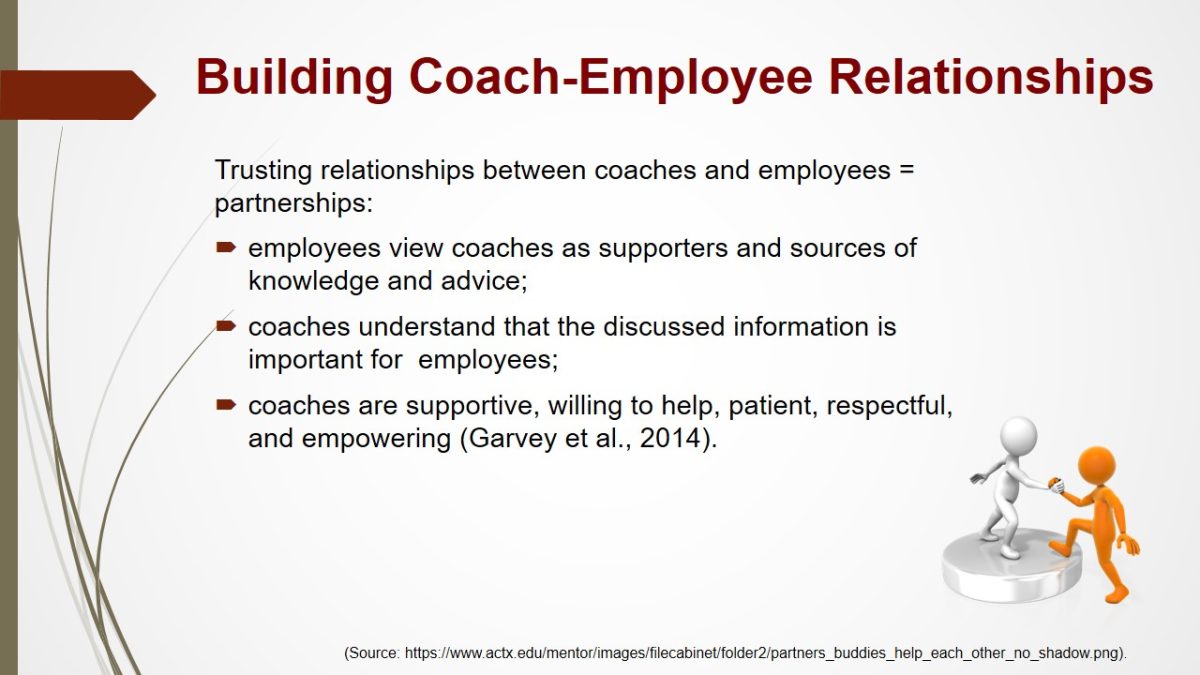
The Coaching Process and Coach-Employee Healthy Relationships
- Coaching Sessions:
- private conversations regarding an employee’s work progress;
- informal and positive;
- oriented to discussing performance in a friendly manner.
- Daily Interactions (individuals and groups):
- answers to questions;
- frequent and motivating (Garvey et al., 2014; Grant, 2014).
Employees need to understand that they are valued!
The coaching process consists of coaching sessions and daily interactions with employees as individuals and groups. If daily interactions can include answers to questions, coaching sessions are private conversations regarding an employee’s work progress. To build healthy relationships with individuals, these sessions should be informal and positive, oriented to discussing an employee’s performance in a friendly manner. Daily interactions should be frequent and motivating (Garvey et al., 2014; Grant, 2014). Employees need to understand that they are valued, and their opinion is important. These principles are also significant to show employees of Indian Creek Foundation how it is possible to build positive relationships with their clients.

Goals, Objectives, and Expectations
- Goals and Objectives:
- set depending on informal analysis of performance;
- directly associated with employees’ needs;
- meaningful for employees;
- present a challenge for employees (Hunt & Weintraub, 2016).
- Expectations:
- the predicted outcomes;
- limited by time frames.
- Coaches:
- assess situations;
- motivate employees to overcome possible obstacles (Theeboom et al., 2014);
- provide feedback.
Coaches need to know how to set and communicate goals, objectives, and expectations for employees. Goals and objectives are usually set depending on the informal analysis of previous performance, and expectations are referred to the predicted outcomes. Goals and objectives should be directly associated with employees’ needs, and they should be meaningful for them. From this point, goals and objectives need to present a kind of challenge for an employee (Hunt & Weintraub, 2016). Expectations should be limited by time frames. Still, if there are some problems and barriers associated with realizing goals, coaches need to evaluate the situation and motivate employees to overcome possible obstacles (Theeboom et al., 2014). As a result, regular assessments are required to provide feedback, support, and encouragement.
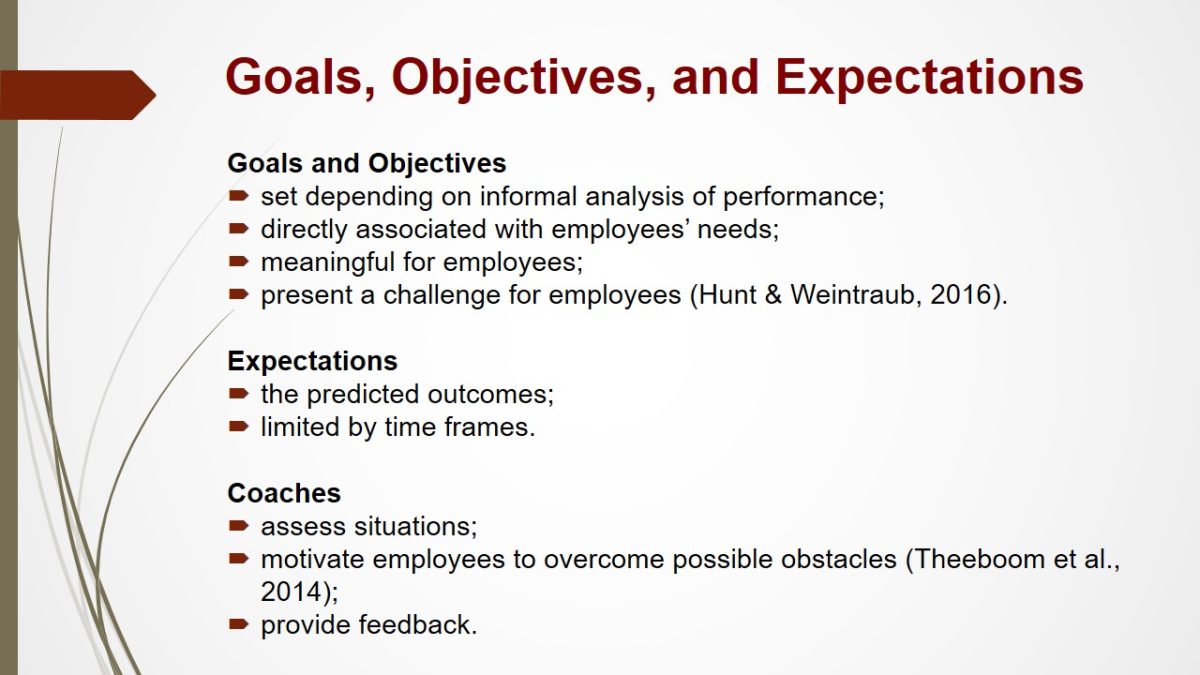
Performance and Feedback
- Coaches:
- monitor employees’ performance regularly;
- evaluate performance;
- provide on-time support and guidance (Berg & Karlsen, 2016);
- provide informal constructive feedback in a positive manner;
- provide advice/rewards (Hunt & Weintraub, 2016).
- Employees:
- develop and perform in a positive work environment;
- receive the helpful and immediate feedback;
- improve performance.
Coaches need not only to help with setting goals and motivating, but they also need to evaluate performance and provide feedback. Benefits of such evaluations and feedbacks are in their informal character. Monitoring employees’ performance regularly, coaches are able to provide on-time support and guidance (Berg & Karlsen, 2016). Furthermore, they can provide the constructive feedback in a positive and informal manner while supporting it by advice or rewards (Hunt & Weintraub, 2016). As a result, employees receive opportunities to develop and perform in a positive work environment, and they can also receive the helpful and immediate feedback to improve their performance.
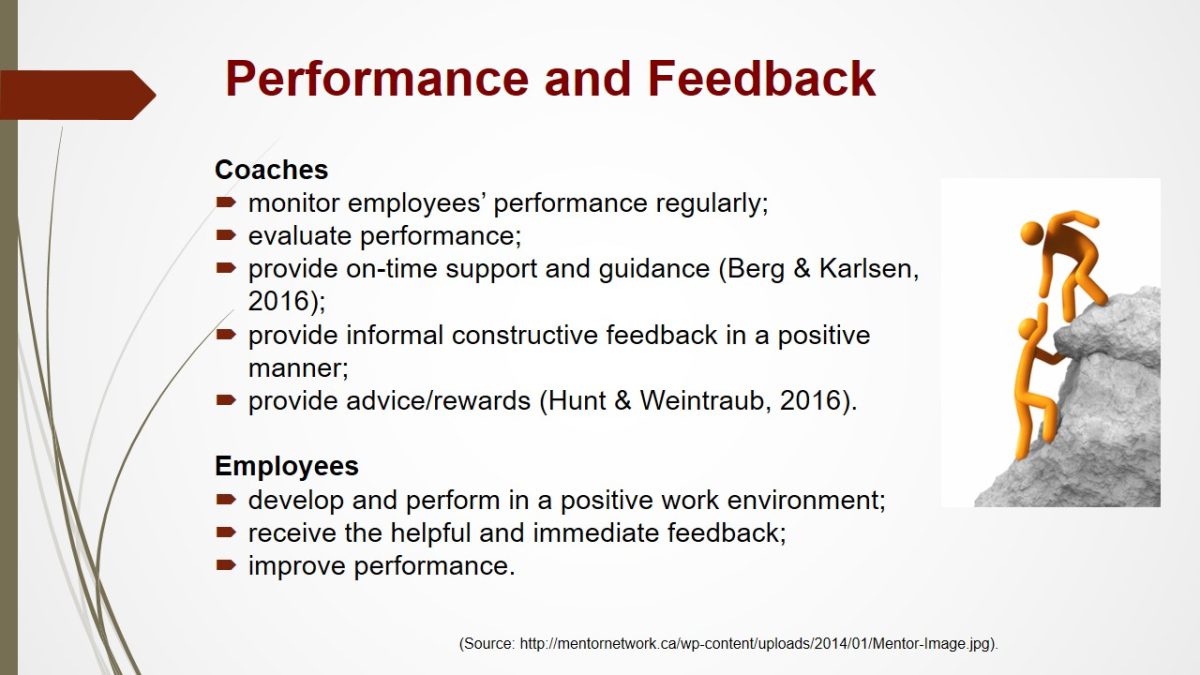
Verbal Communication
- Informal Conversations:
- not structured as lectures;
- messages are communicated clearly;
- words are chosen appropriately;
- statements preserve their direct meanings;
- distorted or ambiguous messages are avoided (Hunt & Weintraub, 2016);
- sarcastic notes and biased statements are avoided.
Informal conversations with coaches should not be structured as lectures. Coaches need to communicate their messages clearly. It is important to appropriately choose words, formulate statements to preserve their direct meanings, and avoid rather distorted or ambiguous messages (Hunt & Weintraub, 2016). Moreover, in their speech, coaches should avoid sarcastic notes and biased statements because they can negatively influence the tone of a conversation and offend an employee.
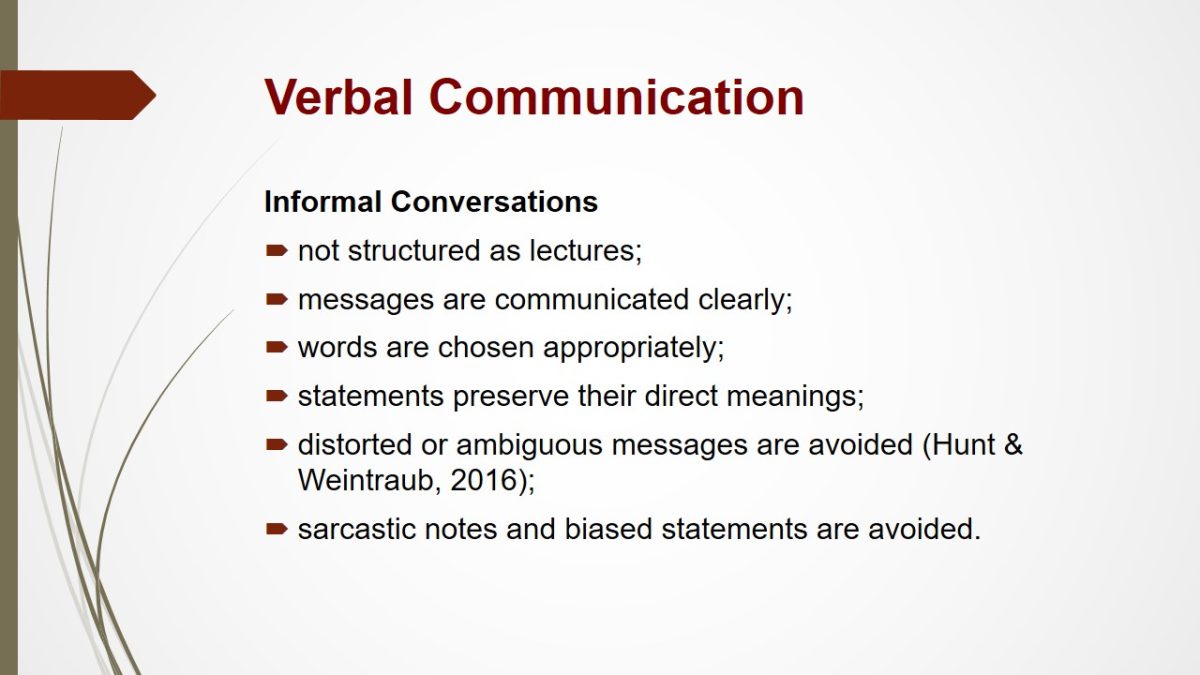
Non-Verbal Communication
- Coaches:
- pay much attention to their posture;
- pay attention to positive gestures;
- avoid demonstrating their authority;
- smile;
- focus on employees’ non-verbal language to conclude about reactions, emotions, and feelings (Berg & Karlsen, 2016).
While speaking to employees, coaches should pay much attention to their posture and gestures to avoid demonstrating their authority. Thus, while communicating with employees, coaches are expected to smile and use positive gestures. Furthermore, it is also important to pay attention to employees’ non-verbal language of their bodies in order to conclude regarding their reactions, emotions, and feelings (Berg & Karlsen, 2016).
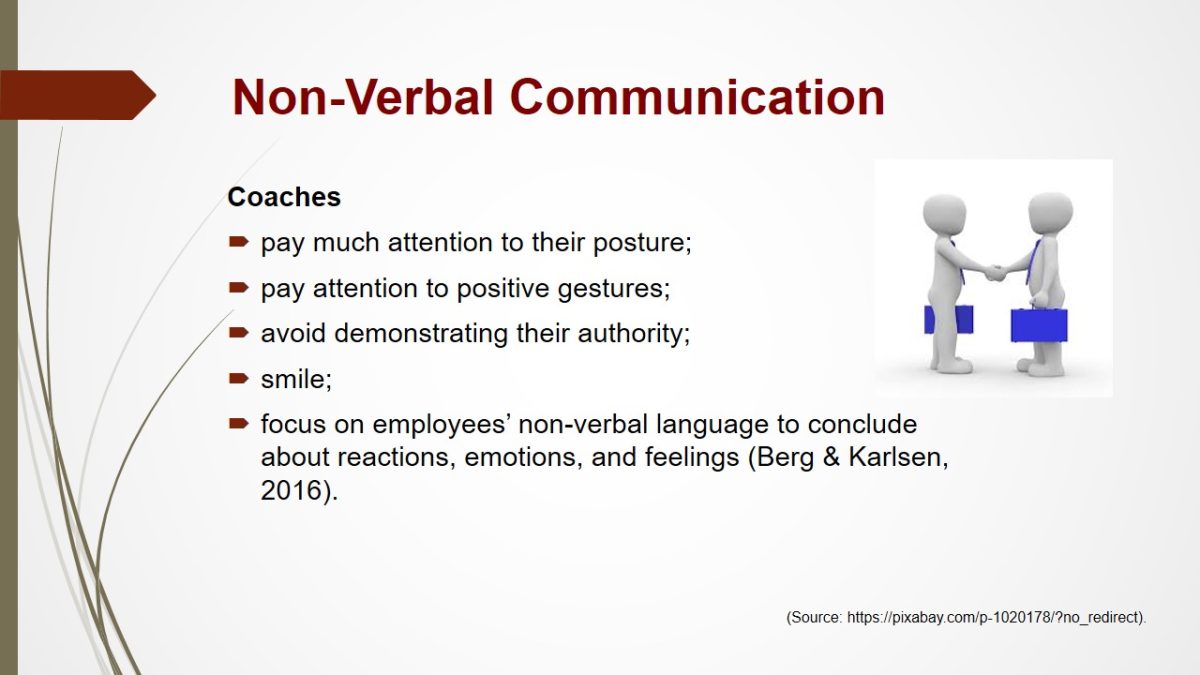
Effective Questioning
- Coaches should ask questions related to:
- positive moments, successes, and achievements;
- performance, challenges, barriers, and risks;
- the workplace atmosphere, commitment, and retention;
- training and development;
- employees’ ideas regarding cooperation improvement (Garvey et al., 2014; Hunt & Weintraub, 2016);
Coaches should listen to the provided answers and make notes.
In order to understand what difficulties employees can experience in their work and what strategies to apply, coaches need to know how to retrieve the desired information by using questions. Coaches should ask the following types of questions:
- questions related to positive moments, successes, and achievements;
- questions related to performance, challenges, barriers, and risks;
- questions related to the workplace atmosphere, commitment, and retention;
- questions related to training and development.
Furthermore, coaches should also focus on employees’ ideas regarding possibilities to improve cooperation in the workplace (Garvey et al., 2014; Hunt & Weintraub, 2016). The main focus is on listening to the provided answers and making notes in order to address the discussed issues.

Face-to-Face Communication
- Conversations should be productive and positive.
- It is important to:
- remove barriers that can distract from discussion;
- maintain an eye contact;
- follow employees’ reactions to discuss some topics in detail or to avoid barriers by changing topics (Garvey et al., 2014).
The face-to-face communication with employees should be productive and positive. Before starting the conversation, it is important to remove all possible barriers that can distract speakers from discussing problems and issues. Furthermore, it is necessary to maintain an eye contact and follow employees’ reactions to the conversation in order to be able to discuss some topics in detail or to avoid barriers while changing topics (Garvey et al., 2014).
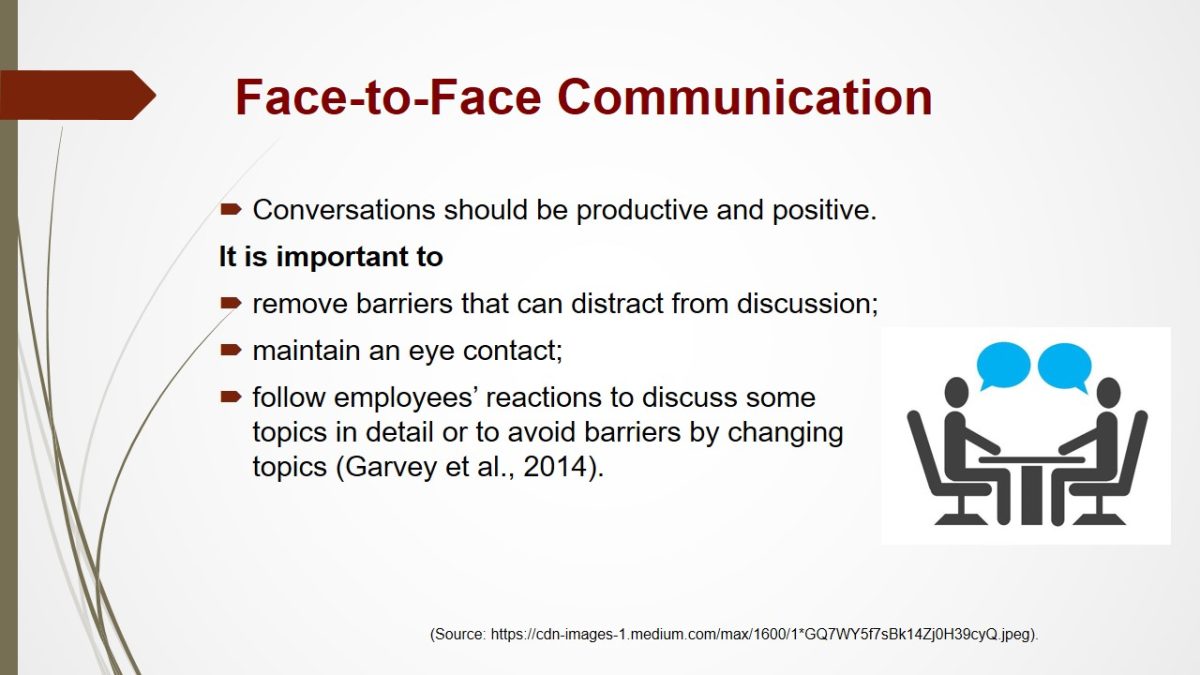
Face-to-Face Meetings
- Do not resemble formal meetings or lectures;
- planned or scheduled;
- informal in their nature;
- oriented to discussing only one or two issues;
- introductory questions– to build a rapport/provide the positive evaluation of performance;
- discussion of problems – to provide support and guidance (Garvey et al., 2014; Grant, 2014);
- concluding remarks – oriented to motivating employees to improve performance.
Face-to-face meetings with employees do not resemble formal meetings or lectures. In spite of the fact that these meetings are planned or scheduled, they are informal in their nature and oriented to discussing only one or two issues. Introductory questions and phrases are developed to build a rapport and provide the positive evaluation of an employee’s performance. Then, the conversation develops to discuss certain issues associated with an employee’s problems. At this stage, coaches provide support and guidance (Garvey et al., 2014; Grant, 2014). Concluding remarks should be oriented to motivating an employee to improve his or her performance.
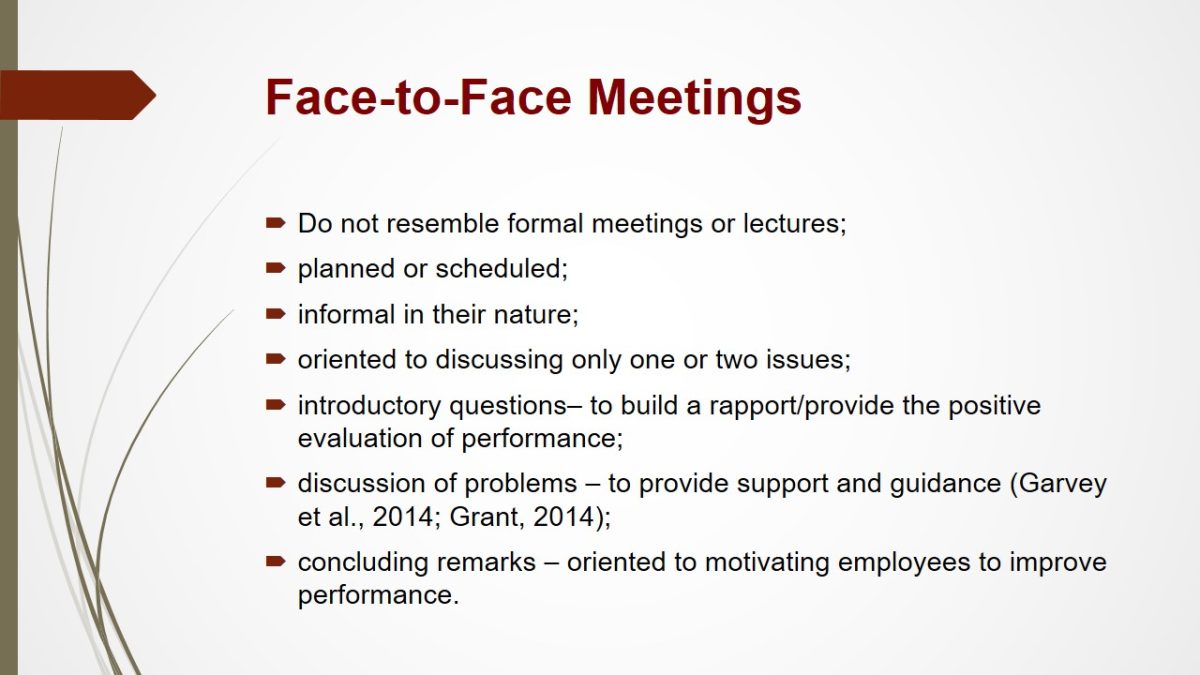
Confrontations
- Non-Productive Confrontations:
- characterized by creating conflicting situations;
- coaches and employees cannot find answers to their questions.
- Productive Confrontations:
- provide employees and coaches with opportunities to solve the problem;
- discuss arguments from all sides and perspectives;
- focus on finding the solution and formulating a decision (Garvey et al., 2014; Hunt & Weintraub, 2016).
It is possible to distinguish between non-productive and productive confrontations between coaches and employees. Non-productive confrontations are characterized by creating conflicting situations, in which coaches and employees cannot find answers to their questions. On the contrary, productive confrontations are important for coaching because they provide employees and coaches with opportunities to solve the problem while discussing arguments from all sides and perspectives. Even if there are opposing points of view, it is possible to find the solution and formulate a decision by the end of a conversation (Garvey et al., 2014; Hunt & Weintraub, 2016). From this point, this confrontation is decision-oriented and productive.
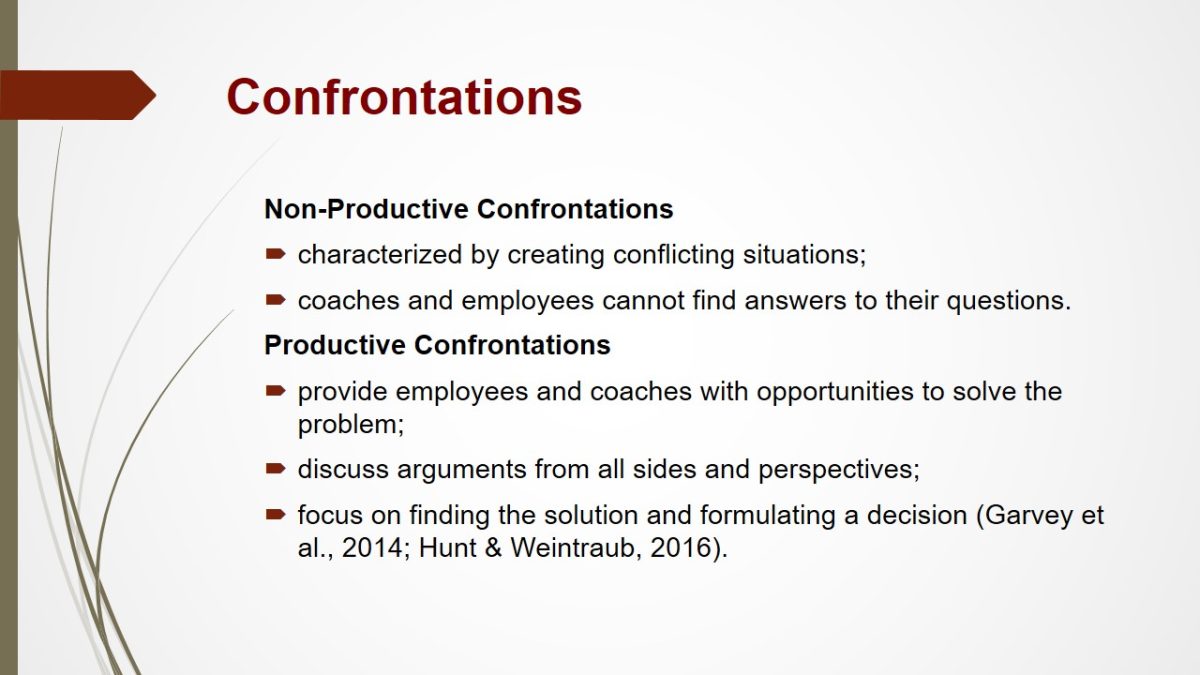
References
Berg, M. E., & Karlsen, J. T. (2016). A study of coaching leadership style practice in projects. Management Research Review, 39(9), 1122-1142.
Garvey, B., Stokes, P., & Megginson, D. (2014). Coaching and mentoring: Theory and practice (2nd ed.). Thousand Oaks, CA: SAGE Publications.
Grant, A. M. (2014). The efficacy of executive coaching in times of organisational change. Journal of Change Management, 14(2), 258-280.
Hunt, J. M., & Weintraub, J. R. (2016). The coaching manager: Developing top talent in business (3rd ed.). Thousand Oaks, CA: SAGE Publications.
Kotylak, S., Michałowska, M., & Danielak, W. (2015). Coaching culture in the context of the emergence of creative class. Management, 19(2), 52-66.
Theeboom, T., Beersma, B., & Van Vianen, A. E. (2014). Does coaching work? A meta-analysis on the effects of coaching on individual level outcomes in an organizational context. The Journal of Positive Psychology, 9(1), 1-18.